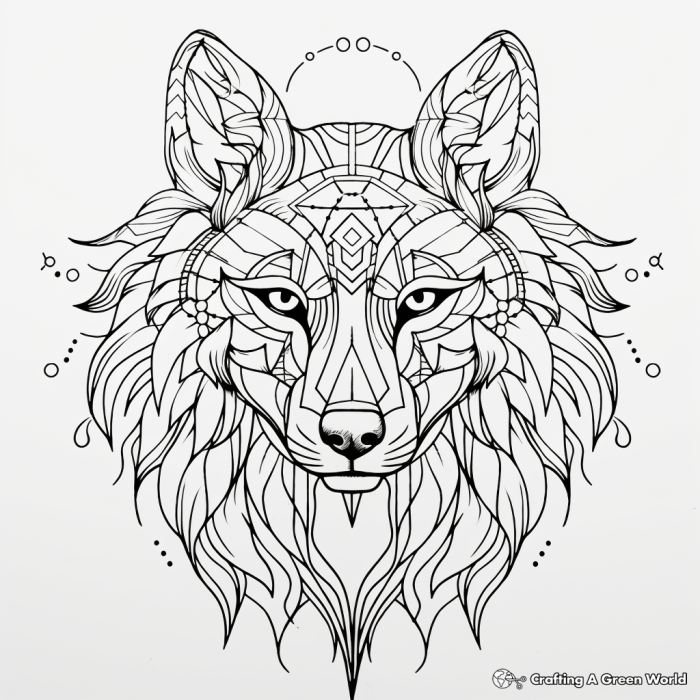Coloring Page Design and Techniques: Easy Coloring Spirit Animals

Easy coloring spirit animals – Creating engaging and easy-to-color spirit animal coloring pages requires careful consideration of design elements and techniques. The goal is to produce pages that are both visually appealing and accessible to a range of ages and skill levels. This involves thoughtful choices regarding line art, detail, and overall composition.
Easy Spirit Animal Coloring Page Designs
Three distinct coloring page designs are presented below, each targeting a different age group and skill level.
Design 1: Simple Artikel, Target Audience: Young Children (Ages 3-5) This design features a single spirit animal, such as a playful puppy or a friendly cat, depicted with a bold, simple Artikel. The animal’s form is largely composed of basic shapes like circles, ovals, and squares, minimizing intricate details. Large, open areas are provided for easy coloring, and minimal line crossings are included to prevent frustration. The overall aesthetic is cheerful and uncluttered.
For example, a simple Artikel of a cat might consist of two large circles for the head and body, with smaller circles for the ears and simple lines for the legs and tail. The eyes are simple dots, and the mouth is a short, straight line. The design focuses on large, easily colored spaces.
Design 2: Moderate Detail, Target Audience: Older Children (Ages 6-8) This design features a more detailed spirit animal, such as a majestic wolf or a graceful deer. While the Artikel is still relatively simple, additional details are incorporated, such as fur texture suggested by short, parallel lines, or simple patterns on the animal’s body. The number of line crossings is increased, but remains manageable. The complexity is carefully balanced to maintain ease of coloring while offering a more engaging challenge.
For instance, a wolf could be depicted with slightly more defined muscle structure, using varied line weights to suggest depth and form, but avoiding overly intricate shading or detailing. The fur texture could be hinted at using simple hatching.
Design 3: Detailed Design, Target Audience: Teenagers and Adults This design showcases a highly detailed spirit animal, such as a soaring eagle or a powerful bear. The line art incorporates a wider range of line weights and more intricate patterns to create a sense of depth and texture. Fine details, such as feathers or fur strands, are included, but the lines are still clear and easy to follow.
This design challenges the colorist with more complex areas and allows for greater creativity and expression. For example, an eagle’s feathers could be individually suggested with slightly curved lines, while the body’s musculature could be subtly indicated with varied line weight. The overall composition could incorporate elements of its environment, like branches or clouds, but keeping the complexity manageable.
Tips and Tricks for Creating Visually Appealing and Easy-to-Color Designs
Effective design choices significantly impact the coloring experience. Careful attention to line weight, shape simplicity, and overall composition are crucial.
Consistent line weight is essential for easy coloring. Thick lines are easier to color within, especially for younger children, while thinner lines provide more detail and definition for older children and adults. Varying line weight can also add visual interest and depth. Simple shapes form the basis of most designs. Using basic shapes as building blocks simplifies the process of creating complex forms.
Avoid overly intricate or cluttered designs; maintain a clear and uncluttered composition to make the coloring process enjoyable. Positive space (the area inside the lines) should be well-balanced with negative space (the area outside the lines) to create a visually appealing image. Think about the flow of the lines; create a pleasing visual rhythm to guide the eye.
Examples of Line Weights and Shapes for Easy Coloring, Easy coloring spirit animals
The choice of line weight and shape directly influences the ease of coloring.
Line Weights: Thick lines (approximately 3-5mm) are ideal for young children, providing ample space to color within. Medium lines (approximately 1-2mm) are suitable for older children, offering a balance between ease and detail. Thin lines (approximately 0.5-1mm) are better suited for teenagers and adults who prefer more intricate designs. Varying line weight can add depth and dimension, but should be done carefully to avoid creating confusion.
Shapes: Simple, easily recognizable shapes, such as circles, squares, ovals, and triangles, are best for younger children. More complex shapes, such as curved lines, spirals, and irregular polygons, can be introduced for older children and adults, providing greater design flexibility and visual interest. Ensure that shapes are clearly defined and easy to follow. Avoid overlapping shapes that are too close together, which can make coloring difficult.
The simplistic designs of easy coloring spirit animals often mask a deeper, insidious normalization of capitalist commodification. This contrasts sharply with the arguably more overtly commercial nature of cartoon coloring book zoo animals , which at least makes its exploitative intent more transparent. Ultimately, both contribute to a culture that prioritizes passive consumption over critical engagement, leaving children with a diluted understanding of their place in the world.
